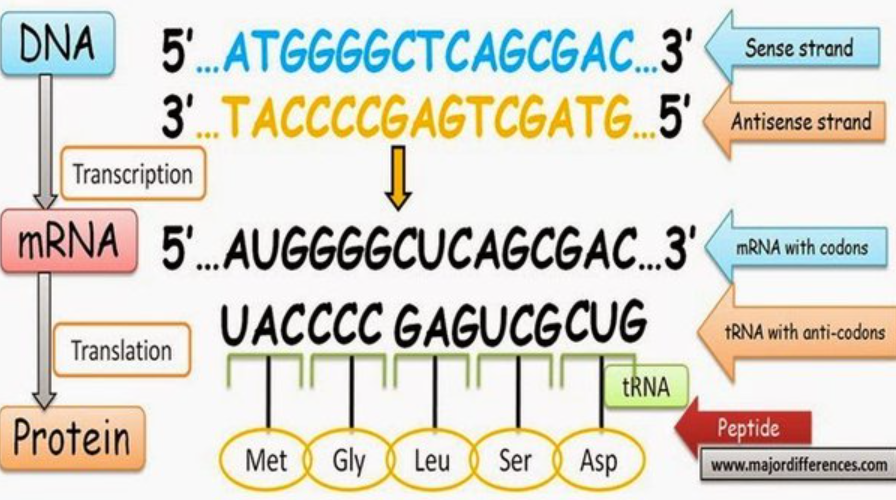Unlocking the Mysteries: The Crucial Role of Complementary DNA Strands

The new DNA strand is complementary to the 3′ to 5′ strands in short segments due to the direction of DNA synthesis. This ensures proper base pairing and accurate replication of genetic information.
When DNA is replicated in the 5′ to 3′ direction, short segments of the new strand are synthesized in opposite directions to match the 3′ to 5′ template strand. This process, known as semi-discontinuous replication, allows for efficient and accurate DNA replication.
The complementary nature of the new DNA strand to the template strands enables the faithful transmission of genetic information during cell division. Understanding the mechanism behind this complementary synthesis is crucial for maintaining the integrity of genetic material and ensuring proper cellular functions.
Contents
What Is Complementary DNA?
Complementary DNA, often referred to as cDNA, is a synthesized DNA molecule that is complementary to a specific messenger RNA (mRNA) in a cell. The process of creating cDNA involves using mRNA as a template and an enzyme called reverse transcriptase to produce a DNA molecule that is complementary to the original mRNA sequence. This synthesized DNA can be used in various molecular biology applications, including gene cloning, gene expression studies, and protein production.
Definition
Complementary DNA, or cDNA, is a single-stranded DNA molecule that is synthesized from a messenger RNA (mRNA) template. It is complementary to the original mRNA sequence and can be used in genetic research and biotechnology applications.
Structure
The structure of complementary DNA is based on the sequence of the original mRNA molecule. It is composed of nucleotides, each containing a phosphate group, a sugar molecule, and a nitrogenous base (adenine, guanine, cytosine, or thymine). The sequence of nucleotides in cDNA is complementary to the mRNA sequence, allowing it to be used in various experimental procedures.

Credit: www.assaygenie.com
The Significance Of Complementary DNA
Complementary DNA plays a significant role in assembling short segments of 3′ to 5′ strands due to their ability to bond with the corresponding nucleotides, ensuring accurate replication and protein synthesis. This complementary pairing ensures genetic stability and fidelity.
Dna Replication
The process of DNA replication ensures accurate transmission of genetic information.
In this process, a new DNA strand is complementary to the 3′ to 5′ template strand.
Gene Expression
- Gene expression is the process by which genetic information is used to create proteins.
- Complementary DNA is essential for proper gene expression and protein synthesis.
- In DNA replication, new DNA strands are assembled in short segments to ensure accuracy.
- The complementary nature of DNA strands aids in maintaining genetic stability.
- Gene expression relies on complementary DNA to produce functional proteins.
The Role Of Complementary DNA In Biotechnology
Dna Sequencing
DNA sequencing is a critical technique in unraveling genetic information.
Pcr Amplification
PCR amplification is a fundamental method to replicate DNA segments.
The new DNA strand complements the 3′ to 5′ strands through short segments. This complementary nature is vital for correct pairing and replication in biotechnology processes. By adhering to this specificity, scientists can accurately synthesize and replicate DNA sequences for various applications. DNA sequencing enables the precise determination of genetic data, contributing to advancements in medical research and diagnostics. Similarly, PCR amplification allows for the rapid production of specific DNA regions, proving invaluable in biotechnological research and genetic engineering.

Credit: www.tomorrow.bio
Challenges And Future Directions
Limitations Of Complementary DNA
The incorporation of a complementary DNA strand to the 3′ to 5′ strands, assembled in short segments, presents several limitations. The process of assembling the new DNA strand in short fragments can be time-consuming and labor-intensive. It also requires careful coordination of DNA polymerase, ligase, and other enzymes to ensure the proper assembly of the segments. Additionally, there is a risk of introducing errors during the synthesis of complementary DNA, leading to potential inaccuracies in the genetic information.
Advancements And Potential Applications
Despite these challenges, advancements in technology have opened up potential applications for complementary DNA synthesis. The development of more efficient and accurate DNA synthesis methods has the potential to revolutionize fields such as genetic engineering, molecular biology, and biotechnology. Complementary DNA synthesis can be utilized in gene cloning, sequencing, and gene editing, offering new opportunities for understanding and manipulating genetic information. Furthermore, the ability to synthesize complementary DNA strands in a controlled manner can facilitate the production of custom DNA sequences for various research and medical purposes.

Credit: chemistry-europe.onlinelibrary.wiley.com
Conclusion
In understanding the complementary nature of the new DNA strand to the 3′ to 5′ strands assembled in short segments, we have gained valuable insights into the replication process. This intricate mechanism ensures accuracy and efficiency, laying the foundation for genetic stability and inheritance.
Embracing this knowledge enhances our understanding of the intricate workings of life itself.




